Activated carbon filters sometimes referred to as charcoal filters contain small pieces of carbon, in granular or block form, that have been treated to be extremely porous. Just 4 grams of activated carbon has a surface area the equivalent of a football field (6400 sqm). It’s the massive surface area that allows active carbon filters to be very effective in adsorbing (essentially removing) contaminants and other substances.
When the water flows through active carbon filters the chemicals stick to the carbon resulting in purer water output. The effectiveness depends on the flow and temperature of the water. Therefore most smaller active carbon filters should be used with low pressure and cold water.
In addition to the surface area active carbon filters may have different capabilities in terms of the size of contaminants they remove. One factor is the quality of the activated carbon with coconut shells proven to have the best efficiency. Activated carbon can also be made of wood or coal and sold as granular activated carbon or carbon blocks.
Another factor is the size of the particles that the filter will allow through as this provides a second defence. Granular activated carbon (GAC) has no specific limit as the material is porous. Activated carbon in the form of carbon blocks on the other hand usually have a pore size of between 0.5 to 10 micron. The problem with the smallest sizes is that the water flow ends up being reduced as even the water particles struggle to get through. Therefore the typical carbon blocks are between 1-5 micron.
Activated carbon can be effective in reducing hundreds of substances including contaminants and other chemicals from the tap water. However, the most cited studies by EPA and NSF claim effective removal of between 60-80 chemicals, effective reduction of another 30 and moderate reduction for 22.
The range of effective removal is important and depends on the quality of the activated carbon used and in what form (GAC vs carbon block). Make sure to chose a filter that removes the contaminants of concern for your local tap water.
Post time: May-20-2022


